
Submitting articles to article directories is what is known as “off page optimization.” Off page optimization is doing what you can to drive traffic to and create back links to your actual web pages. The best search engine optimization involves both on page and off page optimization. Submitting articles to directories won’t help much if your pages have little or no useful content, or if your pages themselves have not been optimized through the use of keywords, meta tags, and anchor text links. But once you have your pages in top shape, submitting articles to directories can definitely give your website’s traffic a boost.
Articles promoting your website should soft sell your site. In fact, many article directories have strict rules about how many so-called self serving links you can include in your articles. That’s because people don’t look for articles in order to be sold a piece of software or a new nutritional supplement: they read articles to gather information. Your job is to provide that information and also provide a way for the article reader to get to your site if he or she so chooses.
Even the article directories that are quite strict about links to your website in the content do provide “about us” boxes or “resources” boxes where you can include links to your site, and you should definitely do this. Anyone interested in the article content enough to want more will be looking to the resources box to link to more information. Because there are so many free article submission directories, you have plenty of outlets for articles about your site. You won’t have a huge influx of traffic overnight, but over time, your PageRank will increase, as will your traffic. Below are several of the advantages and a few disadvantages to directory submission of articles.
As helpful and useful as article directory submission is, there are a few downsides to it.
As an example, look at the first screen shot, where I have entered three woodworking terms into the entry box: woodworking tools, sanding blocks, and table saws. In the second screen shot you see just part of a long list of suggested keywords along with their relevance and search volume. At first glance it looks like the terms “woodworking hand tools,” “antique woodworking tools,” and “woodworking tool” could be good keyword candidates because they’re highly relevant, and the search volume is high, but not so high that I can’t work my way past the competition.
The moral of the story is: when you’re writing articles for submission to articles directories, ignore keywords at your peril. And, just FYI, the top five articles directories, according to vretoolbar.com and based on Google PageRank and Alexa Ranking are as follows: ezinearticles.com (Alexa=131; PR=6), articlesbase.com (Alexa=451; PR=5), buzzle.com (Alexa=1305; PR=5), goarticles.com (Alexa=1601; PR=6), and helium.com (Alexa=1872; PR=6).

There’s an old adage in international marketing circles that says to go global, businesses really have to think local.
Apple recently launched its ubiquitously popular iPhone in China and after more than two months, it had shifted a mere 5,000 handsets. Whilst it is a product that will be unaffordable to many people in China, in a country of more than one billion people, most conservative forecasts of iPhone’s two-month sales figures prior to launch would be at least fifty times that.
Apple failed to consider a number of factors when launching the iPhone, namely Chinese consumers prefer not to sign long-term contracts, opting for charge cards instead, allowing a greater degree of flexibility for the user. This isn’t the only reason it hasn’t taken off, but it’s a factor that Apple really should have considered prior to launch – they should’ve properly researched the market.
At a micro level, it’s easier than ever for the smallest of home-built businesses to network and trade on the international arena. But the first step towards doing so is to build a fully localized presence in your key target markets– and the process begins with adapting your company website for each country you plan to tap into.
Like Apple should’ve done with the iPhone, you need to fully understand your target country, know what excites them and what, ultimately, is likely to encourage them to part with their hard-earned cash.
 The only way businesses should communicate with their international markets is in the native language of the local consumers. Even though English is the most commonly spoken second language in the world, the fact remains that people prefer to communicate in their mother tongue. Furthermore, three quarters of the world’s population speak no English whatsoever.
The only way businesses should communicate with their international markets is in the native language of the local consumers. Even though English is the most commonly spoken second language in the world, the fact remains that people prefer to communicate in their mother tongue. Furthermore, three quarters of the world’s population speak no English whatsoever.
Contrary to what many people think, fluency in a particular language doesn’t qualify someone to translate into it. To provide convincing translations, the translator requires first-hand knowledge of the culture of that language which is why most translators will only ever work INTO their native tongue from another language in which they are fluent.
Furthermore, many linguists will specialize in a particular subject – such as marketing, engineering or agriculture. If your company’s products or services involve highly technical terminology, you will probably want to consider checking with the translation company that they have suitable candidates with the right level of experience.
The important thing to remember when translating your website or any other marketing material is that what works in one country, might not translate the way you want it to in another. What’s clever and witty in one country, might be offensive in another. This is something only a native-speaking translator will know.
It’s also important to be wary of dialects within languages. If you translate your website into French, it doesn’t mean you can use it for all French-speaking countries.
In France, a ‘post-office box’ is a boîte postale, but in Belgium and Switzerland it’s a case postale. In France, ‘lunch’ is déjeuner, but in Belgium and Switzerland the word for ‘lunch’ is dîner which, incidentally, is the word for ‘evening meal’ in France. There is a whole host of linguistic nuances between the French, German and Portuguese dialects of the world. Even closer to home, the English in the US and the English in the UK are significantly different…not to the point of requiring an entirely different website, but certainly to the point of requiring significant care and attention when writing the English text.
When marketing internationally, the words ‘language’ and ‘local’ should always go hand-in-hand. Failing to do so can lead to a very costly global venture for businesses where funds may be limited.
About the Author
Article by Christian Arno, the Managing Director of Lingo24.
Visit Christian’s website at www.lingo24.com.

Press release websites can be one of many search engine optimization tactics for your website. They give you back links, and will reach people that you wouldn’t reach otherwise. There are a number of paid websites like PR.com, Marketwire, and PRweb. Just as an example, PRweb (shown in the first screen shot) offers two levels of visibility, high visibility, which costs $199 a year, or platinum, which costs $499 a year.
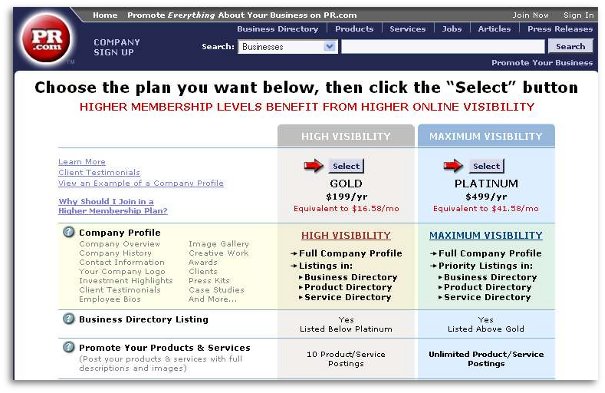
Are these services worth it? Only you can answer that. It will depend on your budget and on whether you think the investment will pay off in terms of higher ad revenue on your site or better conversion rates. Paid PR websites offer company profiles listed in various directories, plus paid and free press release distribution, and anchor text links.
When you write press releases, whether for paid or free PR sites, always write for your audience. Targeted traffic is what you want. Have you ever found blog posts with very provocative titles that turn out to be about something else completely? That’s not what you want to do with press releases. You have to be genuine. After all, if you have great content, the people who visit are more likely to stick around, bookmark your site, and generate lots of page views.
That said, use the anchor text and headline in a press release to focus on your targeted keywords. Use the headline to focus on one of your primary keywords, and use links sprinkled throughout the press release. If the PR site you’re using gives you a resource box, an “About Us” page, or a profile, these are all good places to provide a link to your home page. Use the links within the press release to link to more specific, relevant content.
 Theopenpress.com (see second screen shot for some of their guidelines) is a free service as long as you follow their guidelines to the letter. They don’t edit free press releases, so if the ones you submit don’t meet the guidelines, they simply delete them.
Theopenpress.com (see second screen shot for some of their guidelines) is a free service as long as you follow their guidelines to the letter. They don’t edit free press releases, so if the ones you submit don’t meet the guidelines, they simply delete them.
PR Leap has free and paid services that kick out your press release where it can be seen by bloggers, consumers, and journalists, reaching all the main search engines, news websites, and newswires.
PR Inside is another free press release service. You create a free account to submit press releases. The home page is a repository for the latest press releases, which are not catagorized. It’s free, and no doubt has a lot of readers, but the right person seeing your press release appears to be largely a matter of coincidental timing, so this shouldn’t be your sole press release outlet.
i-newswire.com allows free press releases to be submitted as long as they aren’t spammy (“Buy Our Awesome Software Today!” and the like). Free press releases are not allowed to have any graphics or links in them. This site also has paid accounts, which offer more perks.
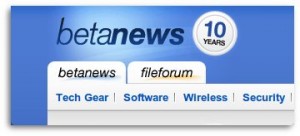 betanews.com is a tech-oriented news site that you can join for free and submit content to. It caters to IT professionals, programmers, site designers, computer security, and relevant legal issues.
betanews.com is a tech-oriented news site that you can join for free and submit content to. It caters to IT professionals, programmers, site designers, computer security, and relevant legal issues.
If you’re interested in comparing several paid and free press release websites side by side, Star Reviews has such a comparison here.
The general idea behind using press release websites is that you should exhaust all the free possibilities before going to a fee-based service, unless you just have a generous budget to begin with, which most people don’t.
Perhaps the most important rule for writing press releases is to make them newsworthy. People and press release sites are good at filtering out the so-called press releases that are actually sales pitches. You might have something they’re interested in, but if their first impression is “spam press release,” they’ll scroll right on by it.
If you don’t know how to write a press release, or don’t think you’d do a good job, there are plenty of copywriters out there willing to do it for you. You may be able to find someone who has written for the very sites you want to send the release to.
Since most free press release sites require you to create an account, go ahead and register with several of them at once – at least 10 or 12. That way when you have your press release ready to go, all you have to do is copy and paste it properly for each press release site. Proofread press releases meticulously before submitting them. Some sites won’t let you change press releases after they’ve been submitted, and you don’t want to be the guy advising software buyers to “be perpared.”
If the site allows graphics, audio, or video, and if you have it, be sure to include it. Keep track of the places you submitted your press release to and whether or not people read it. You can do this in a spreadsheet if you’re the organized type, or you can use a simple pen and paper to keep track, but you need to do this so you’ll know which sites give you the most exposure for your time and effort.
Learn when to hold back. Once or twice a month is a good frequency with which to send out press releases. Once a day is overkill and people will rapidly come to recognize your press releases and ignore them. Once you find the sites that you like best, it’s a good idea to stagger your releases. If you submit to ten sites in one day, it will scroll off of ten sites pretty much at the same time. If you stagger your press releases, you’ll have them on at least one site at all times.

The relationship between targeted traffic and search engine ranking page (SERP) position shows that search engine optimization, or SEO, treads a fine line between being an art and being a science. Obviously there are specific algorithms that are used to rank sites for a given search query, but finding out exactly how they work is shrouded in mystery.
Even without, say, Google giving up how its search engine ranking is determined, every time there is a new factor taken into account by an algorithm, SEO researchers are pretty quick to learn in general what that new factor is, and less scrupulous site owners are ready to pounce with less than honest ways to try and game the system.
One fairly recent example is back links. Once it became general knowledge that search engine ranking and Google PageRank took back links into account, “link farms” and sites where you could buy links sprung up like so many mushrooms after a rainy spell. It was then Google’s turn to ferret out sites using these techniques and either de-list them or drop their rank significantly.
It’s like an arms race: as soon as people figure out and exploit some “new” wrinkle in SERP generation, the search engines have to find a way to stamp dishonest practices out. Otherwise, the search engines aren’t worth much to people doing real searches. This arms race continues because making it onto the first page of search results is good, making it “above the fold” (in the upper 700 or so pixel rows) is better, and ranking number one is best.
In 2006, some AOL search engine ranking data was leaked, and SEO researchers pounced. The analysis showed that the number one position brings with it a 47% average click through rate. Positions two, three, and four have click through rates of 13%, 9%, and 7%. Clearly, bringing your ranking up from third or fourth to first makes an enormous difference in a site’s traffic and its bottom line if it is a commercial site.
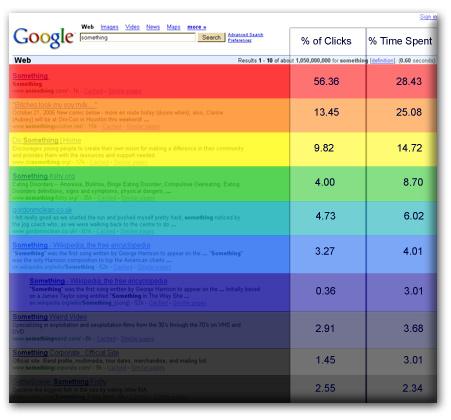 Of course, these figures are only approximations, but they do seem to hold water. People notice great differences between their statistics between the top rankings. Anecdotal evidence suggests that going from the #2 to the #1 spot can increase traffic by 100% or better. Dropping from #1 to #2 corresponds to a 30% to 50% drop in search volume.
Of course, these figures are only approximations, but they do seem to hold water. People notice great differences between their statistics between the top rankings. Anecdotal evidence suggests that going from the #2 to the #1 spot can increase traffic by 100% or better. Dropping from #1 to #2 corresponds to a 30% to 50% drop in search volume.
As you move downward through the first SERP, the rate of decline of click throughs falls, and one interesting quirk that could be an artifact is that the number 10 position gets a slightly higher rate of click throughs than the number 9 position. Some speculate that users will be more likely to glance at the last listing while scrolling down to suggest searches or page navigation buttons. Once you move off the first SERP you’re close to being invisible. For all but the very highest volume queries, the non first SERP listings will generally offer no benefit to site owners except in unusual situations.
A factor in your SERP position is the quality of your site’s meta data. To ensure that your web pages get the best shot at appearing high in the search engine results, you need to give some thought to the meta data in your web pages. Meta data is data describing other data. For your web page, meta data includes things like the page title, keywords, and description.
In Google, the display of a “snippet” of your site will be longer, the longer the query is leading to the site. In other words, a detailed query that hits your site will sometimes show a three line snippet rather than the traditional two line snippet. The main reason this makes a difference is that it can in some cases limit the results shown “above the fold” to the top three results rather than four.
As you can see in the accompanying screen shot, a search on “chloe light gray leather riding boots” results in a long snippet for the top result, though the others in the top ten are still short snippets.
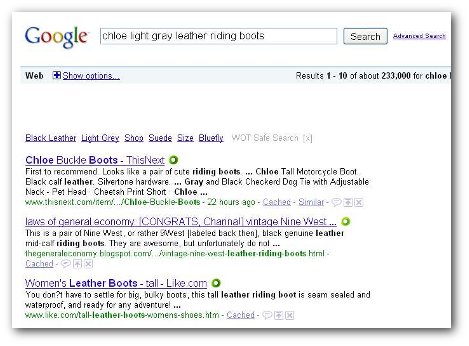
A good snippet can improve click through rates, and you can be sure that if extended snippets cause only three listings to show above the fold, then position in the top three results becomes even more important. In other words, yes, people are too lazy to scroll down in many cases.
Now, while the extended snippets come from actual content of the page it refers to, meta data is used in other cases. A well-optimized page has a title containing the target keyword phrase, and the keyword phrase from the title (with slight variations) should be made of phrases most used to find your page in the SERPs. Putting all the title keywords into the meta description will maximize the number of times your meta description is shown as your snippet. If the meta description contains all of the keywords from the user’s search phrase, it will be used as the search snippet for your page.
The meta description should also contain, if possible, a call to action that will make the user want to click on through to your site, and the description should be accurate so that the user doesn’t jump right back to the SERP from your site. A well optimized meta description, title, and a URL that is rich in keywords can all work together to boost your click through rate even if your site is ranked third or fourth rather than first on the SERP.

Former U.S. Representative Tip O’Neill’s famous quote that “All politics is local” can in some cases be applied to internet searches. What it means is, never lose touch with your constituents, or in the case of a business, your customers. If you have a bricks and mortar business and don’t sell online, then in your case, “all search engine optimization is local.” Local customers often search for local listings, whether for simply the phone number, store hours, or just to find out more about local businesses. If you don’t optimize your site for local searches, you could be losing more business than you think.
Google Local Business listings usually only show up when the user types in a category of business and a city. When that happens, Google Maps shows up along with anything up to 10 URLs listed next to their phone numbers. You don’t want your competitors to show up on that map with their phone numbers if you aren’t showing up there. If you are, for example, a cosmetic dentist in Atlanta, you want local people to find your practice in as many ways as possible: from offline ads, yellow pages, or online searches.
Look at the screen shot for this very search, “cosmetic dentists atlanta.” As you can see, several practices are listed, their locations are shown on a map, and their phone numbers are right there. There are plenty of things you can do as a business owner to get local people to find your website and your actual business. For one thing, you can ask for back links to your business from other prominent sites.
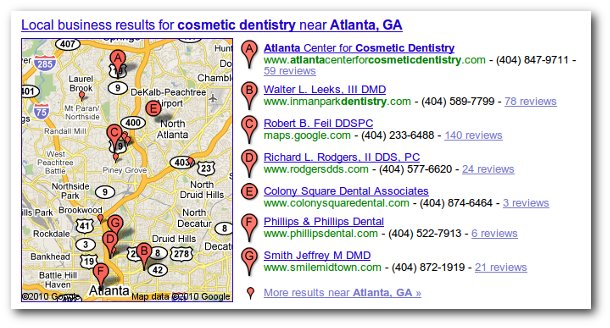
For an example in keeping with the cosmetic dentists in Atlanta theme, suppose you, the cosmetic dentist, were to type in “cosmetic surgery atlanta.” You’d get a page like this second screen shot. Suddenly you see, in this case, seven local cosmetic surgery practices from whom you could possibly solicit back links and offer your own back link to their site. Back links aren’t everything, but they are important in the world of search engine results.
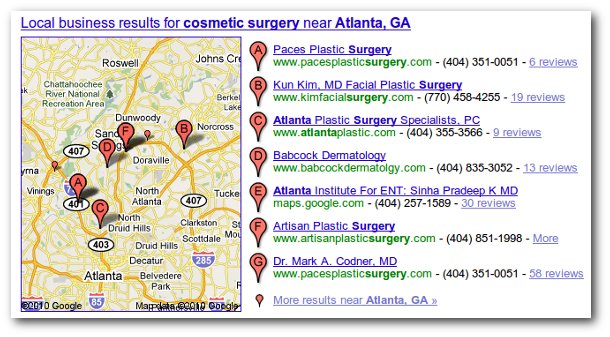
List your business and website in as many free online directories as possible. There is evidence that Google may use your business’s phone number to boost your local ranking, so any time you write a description of your business on a third party site, include the phone number. Also, make sure that all your business listings are as complete and consistent as possible.
If you can include images, coupons, or even a video along with the basic name, address, phone number, and business hours information, so much the better. Use good keywords in your directory listings too. For example, in this instance, good keywords might include “veneers, laser whitening, dental makeover” while the keyword “teeth” would be too broad and vague to help you much.
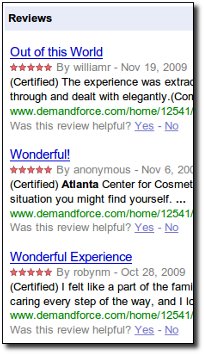 And there’s nothing wrong with looking at those local businesses that rank at the top and looking at what they’re doing in their local listings. They may be doing something you hadn’t thought of, like offering a coupon on their website. Another important factor in optimizing your site and listings for Google Local is customer reviews. Put a link from your site’s home page to a directory listing and encourage customers to review your business. The more reviews you get, the better.
And there’s nothing wrong with looking at those local businesses that rank at the top and looking at what they’re doing in their local listings. They may be doing something you hadn’t thought of, like offering a coupon on their website. Another important factor in optimizing your site and listings for Google Local is customer reviews. Put a link from your site’s home page to a directory listing and encourage customers to review your business. The more reviews you get, the better.
In your website itself, include your business name in the title tags, description, and content. Make sure that your site contains the address and phone number on every page as well as city and state in content, titles, headers, and descriptions.
Claim and verify your business in the Google Local Business Center, and ensure that the information is correct in data providers like YellowPages, Localize, Acxiom, and InfoUSA. These data providers supply many online business directories. If your business has recently moved or changed its phone number, make sure inconsistencies in all listings are fixed. You want all your listings to contain the correct and up-to-date information about your business.
Be sure to claim and verify your listing in directories. You would be surprised how many businesses don’t do this. Gain the upper hand by getting there first. Proper categorization of your business in Google Maps can make an enormous difference to the success of your local business listing. Make the mandatory category describe accurately what your business does. Reserve a few of the fields for custom categories that might be unique to your business. Keep your categories from overlapping to get the most mileage from them, and keep categorizing consistent in directory listings and anywhere else on the web such information is found.
With Google Maps, the description field should state what it is that sets your business apart and makes it the one people should trust. You only have 200 characters in which to do this, so you have to be brief: do you have a patent on a technique you use? is your business the oldest of its kind in town? Capitalize on what sets you apart.
You are allowed to add 10 images and 5 videos to your listing, and you should take advantage of this. Pictures that work well for your listing are your business logo, brands you carry, pictures of your business, and logos or badges of associations you belong to, like the local chamber of commerce or the Better Business Bureau. You can even include videos of your commercials or interviews you may have done on local television!
Put your business’s name out there on as many internet yellow page (IYP) sites, niche directories, local business directories and other trusted sites as possible. Mentions of your business information on several places on the web will help optimize your Google Local listing. If you haven’t taken these steps toward optimizing your Google Local listing, take the time to do so. Chances are you’ll see a real improvement in both web and real-world traffic to your business.
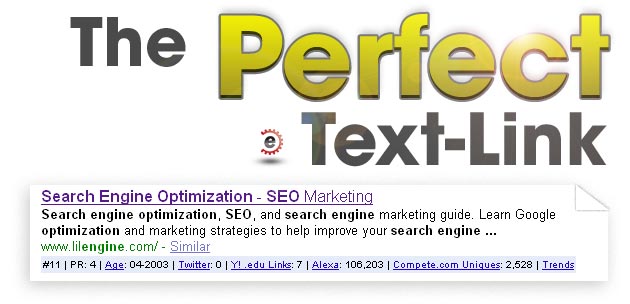
I find myself often on the hunt for that one great link. Many people simply do not realize the impact one text link could have on your website, its natural search ranking, and trust and authority of your website as viewed by the search engines.
Wherever I am around people — community functions, industry events, sporting events, ANYWHERE pretty much—a constant thought is “Hmm, I wonder if this person could help me get a link, or do they know someone who can help me get a link.” It is unfortunate but Matt Cutts is right: the best links are not bought or sold or gained by email spam. They are ones you network long and hard to get, and they are not easily accessible.
Pardon me for a moment to clarify: we all know that one link is not going to make your website the next Amazon.com. But what this one great link can do is make everything else you have done to your website become much more important. If you get the one great link you have been looking, for guess what happens? Every other link to your site typically becomes more valuable, every updated title tag on your website becomes that much more relevant, those hours of perfecting your internal link structure all seems to be coming together.
These great links are not easy to find, even a creative full time link builder like myself can typically only produce a few of these per month, and this includes 12 years of experience, and 12 years of relationships. The average webmaster might only find one link like this per year! Some webmasters pass up link opportunities because usually it comes with a bunch of red tape, prerequisites and potentially gift giving to obtain it, so they procrastinate and just say no way. (And if you run across one of these great links and aren’t going to jump through the hoops to get it, email me, I will take it. )
However the value can be supreme: I have personally seen one link take a website in a somewhat competitive niche to number one after being in place for a period of 120 days. I’m not saying there’s a magic bullet, but the effects of your hard link building work pay off when powerful links come into place. Also this link continues to pay dividends as it grows more important over time.
You probably now want to know what this great text link looks like, so when it comes around you will be prepared to grab it. It will be from a website that has been online since the late 80’s usually around 1986-1988. It will have a minimum of a Google Tool Bar Page Rank of 7 but typically the great ones are PR8’s +. It will be in the top 5000 in Alexa Ranking and have VERY few external links. As for backlinks, it should have so many that no one could possibly count, but if you do a link:www.thegreatsitelocation.com you will see Google showing somewhere in the 10K range and in Yahoo you will see 250K plus.
It may not be on a directly related website, as I am sure there are not many PR8 websites on the net selling baby strollers, but you can work around this when it comes to a fantastic link. These are not the only prerequisites of course, you’ll need your own intuition built from your own link building experience, and I usually have a gut feeling when I find one. What any SEO will fully agree on is a link that fits this profile is very valuable and if you are serious about your internet marketing, then you better get out your check book or your scissors (so you can cut through all the red tape that is going to be involved) and get this link.
Share this post http://bit.ly/B98o2 . Sphinn this post
Hope everyone’s having a great weekend, short and sweet post today of 7 tips to become a better SEO.
A search engine optimization specialist is a dime in a dozen nowadays, everyone from designers, developers to your marketing executives are calling themselves SEOs. There is a misconception that been an SEO simply involves some knowledge of how search engines work and getting links.
1. SEO for glory not for money. What separates the good from the bad is that great SEO work for the results. If your sole focus to become an SEO is for the money, than my last 9 tips will seem like a nuance. Great SEO work for the glory of the results. The pride of seeing their hard work bare fruition is something most people don’t understand, sure you shouldn’t get too emotionally attached to your work. But the driving force of good SEO is their passion to deliver the results.
2. Willingness to learn. No great SEO will claim they know everything there is about search engine optimization, those that do should be questioned about their knowledge and proof be shown. SEO has been and in my opinion will continue to be an evolving industry. As the world demands better search results from search engines, companies like Microsoft and Google will continue to change their services to fill the demand. It is a pre-requist for any SEO to constantly educate themselves. A simple question to ask when hiring an SEO. ( what publications, blogs, websites do they frequent and contribute to )
3. Willingness to share. SEO is a community based industry, a lot of work comes from referrals. And if you are unwilling to share your ideas with others and join discussions. You will find yourself a very lonely SEO with no work. I am not implying that to divulge your company secrets or all your knowledge to the world, once you become part of the community and build solid relationships with other SEO’s that you trust, this is where sharing of ideas can really bring great benefits.
4. Under sale, over deliver. We have all come across the loud mouth, Cr*p talkin salesmen that promise the world but can’t deliver the product. Don’t be that person, if you are in a client facing role, a great SEO presentation will include facts, accurate projections and great presentation skills. Always be honest with your clients when dealing with deliverables and results, sure most client won’t understand what it is exactly us SEO’s do but a great SEO should have the ability to ‘dumb’ down the answers. Be conservative in your traffic projections because when you over deliver results, everyone is happy.
5. Develop your analytical skills. A great SEO needs to possess an analytical mind, be able to gather data from different sources and combine / analysis the data to determine a favourable outcome. How can you perform an accurate keyword analysis, traffic projection or simply how many backlinks to acquire if you don’t have good analytical skills.
6. Learn to use these tools. Your job as an SEO will often require you to use these programs. Don’t rely on sys admins or designers to do the work, otherwise you could be waiting a long time, SEO is a time dependent service. The quicker you start, the faster you will see results.
7. Develop your creative mind. No one likes a robot or a drone, SEO is a creative process that requires you to create solutions for many different clients in different markets. If you are a freelance or inhouse SEO, having a creative mind will help you with your sales pitch, if you can consistently put forward new ideas to your clients that will increase their traffic, they will love you for it. Ideas can be big or small, such as these simple creative link-building concept.
I hope you have enjoyed these tips and have taken away some ideas to help you on your SEO journey. As always, if you agree or disagree with my views, please share them in the comments.
Share this post http://bit.ly/13iV6b . Sphinn this post.
Ask yourself, why are there so many wannabes in the SEO industry and why do they appear to be a brainless army of zombies dwelling in the realm of repetitive and low value activity.
Think about all the blog commenting, forum signatures, cheap and fluffy article distribution, countless directories and paid reviews. The answer could be in the fact that a lot of these processes seem very easy to replicate.
Let’s look at online directories. There used to be a few, fairly well moderated, carrying a reasonable link value. Naturally some genius thought –
‘ Hey, why don’t we make more directories and give ourselves more links!? ‘
Soon after that, link directories were popping up like mushrooms after rain. What did search engines do next? Devalue! Great. Thanks guys.
The above mentioned scenario replicated in countless other cases, and all of them exhibited one common element – they were easy to do, and easy to replicate.
Let’s face it, there is no long-term shortcut to easy SEO results. Instead, we can hope occasionally catch a wave of a new strategy that search engines have not caught on yet, or we can choose to do it the other way – the hard way. The reason this strategy is worth adopting is the fact that people are lazy and only true professionals will bother with hard work and high quality. By eliminating about a ninety percent of spammers leaves us with true SEO professionals. Wouldn’t you want to belong to that category? The crop of the cream!
These are just a few key elements that characterize a unique link building strategy and all of them result in contributing to the quality of the web content. Not all links are difficult to get this way, at Dejan SEO we’ve been using these methods to stay ahead of the competition and it has paid off.
It’s not only our clients who benefit here but also our staff who are able to bypass the monotony of link building and enjoy their daily tasks knowing that every next day brings a new challenge.
Please comment on this post by sharing your creative building strategy or experience with other readers. Share this post http://bit.ly/TJV6g
This is a Li’l Engine guest post by Dejan Petrovic of Dejan SEO – Follow Dejan on Twitter if you like to get more tips on link building strategies.
I was asked by a friend today if posting comments on blogs with no follows is a good way to build links for SEO. When I asked him what other strategies he had for acquiring links he mentioned this was going to be primary source of link building!
Just like the good old days where keyword stuffing and meta tag stuff used to work quiet well, search engines and especially Google are now catching on to comment spamming.
Links in comments are now devalued regardless whether or not if they have no follows. This is a direct response to the huge amount of spam comments now appearing on blogs, if you have ever ran a blog of your own, you will know what I mean, even the most obscure, hard to find blogs on the strangest topics can attract spam comments.
Its actually not hard for search engines to determine if a link is from the comments section of a blog, a quick look at the code in wordpress.
<ol class=”commentlist”>
<li id=”comment-1372″>
<a id=”comments”>
Not hard for search engines to look for these tags and devalue the link-juice within them is it?
While comments are no longer useful for link-juice / reputation passing, they are still useful for the following reasons;
Driving qualified traffic
Lets say you own a fishing / lure store and you come across a blog post from someone complaining he isn’t catching any fish. This would be a perfect opportunity for you to leave a comment with fishing tips and suggest some lures he could use; at the end of the comment, be honest and say you own a fishing store where they purchase these products, with one link to your website, not ten!
You already have the target audience thanks to the blog post, now its simply putting together a well constructed comment.
Be mindful how you structure the reply, comments that look like a cut and paste job or advertising fluff will be deleted. Trust me, these type of comments are not hard to spot.
Ask yourself, are you providing any added value to the post, if a friend came to you with a complaint that he isn’t catching any fish. Are you going to give him a bunch of random lure names without telling him why he should use them? Of course not, be conversational. don’t write your comments like robots, because they will be treated like one.
Quicker Indexing
Comment links can also be used to get your website indexed quicker by search engines, if your website is new and not showing up in Google index; it is most likely in Google’s Sandbox.
A method I have found to be useful is using blog comments on popular blogs to naturally drive Googlebot to your sand boxed website.
Follow the advise above with comment structure and don’t spam. You will find once you have a few decent comments approved on blogs, it will move out of the sandbox faster, in most cases I have found this process to be faster than manually submitting your website to Google.
( Don’t forget to setup a Google webmasters account, if your sites not been found it could be other issues causing it, don’t assume its just been sandboxed, I will be posting about Google Webmaster Tool soon, stay tuned )
Making Connections
Blog commenting is one of the simplest form of Social Media Marketing! Good comments generate discussion, and this is what every blog owner wants. Subscribe to comment updates via email so you know when someone else has responded to your comment, this is where you can really engage with your target audience and offer your services / products.
Good comments can still land you juicy backlinks, most blog owners appreciate good comments and will reward you with a link from an actual post perhaps mentioning how your fishing lure has helped him catch more fish!
Not only do you get a backlink from an actual post which would pass on the link juice, you have just gained yourself a loyal customer that will potentially refer others to your website.
So hopefully you will take my advice and stop comment spam once and for all on the internet!
But seriously, blog commenting is a great internet marketing tool, but for link building purposes they are clearly not as useful as they used to be. If you are solely focused on an SEO campaign, cross off blog comments please!
The buzz within the search marketing industry is torn between 2 of this quarters biggest announcements:
1. First been the search partnership of Bing ( Microsoft ) and Yahoo! ( more )
2. Secondly Google has announced a major update to its search infrastructure code named #caffeine
[ don’t forget add our RSS or Twitter to get notified when part 2 is released ]
On August 10th, the Google Webmasterblog announced public testing of their new #caffeine search quoting :
For the last several months, a large team of Googlers has been working on a secret project: a next-generation architecture for Google’s web search. It’s the first step in a process that will let us push the envelope on size, indexing speed, accuracy, comprehensiveness and other dimensions. The new infrastructure sits “under the hood” of Google’s search engine, which means that most users won’t notice a difference in search results. But web developers and power searchers might notice a few differences, so we’re opening up a web developer preview to collect feedback.
The caffeine update is been reported as a complete rewrite of Google’s search infrastructure – lets check out what this means;
The new infrastructure sits “under the hood” of Google’s search engine, which means that most users won’t notice a difference in search results
Yes most definitely, although Google is stating otherwise ( for now ). When we first heard about #Google #Caffeine I posted this question to Matt Cutts from Google.
john chen August 10, 2009 at 7:47 pm
Hi Matt,
Been sussing this out all morning, from the Google blog and your post its seems there are algo changes / updates on the current sandbox. I’ve noticed some definate changes in the how the SERP is different in the sandbox in my play this morning.
Could you confirm this?
Matts response was:
john chen and Daniel Sterling, most of the changes are in things like our core indexing, so there’s less changes for things like rankings. Lots of users won’t notice a big difference
From our own research and you can verify this yourself in the #caffeine sandbox, this is simply not the case! There are major differences in Caffeine SERP that will ultimately effect users, SEO and most of all companies that depend on their search positions.
These changes come from our initial research in comparing a sample data of searches, and by no means represent a concrete conclusion. Google caffeine is still under development, as such the algorithm and infrastructure will change and alter in the near future. These are just preliminary conclusions for your consideration ( food for thought ) and therefor I recommend that you make no immediate changes to your SEO strategies, but simply keep the above in mind.
Google has released #caffeine for general public testing here![]()
If you are after a direct comparison tool between #caffeine and current #google search Try http://www.goobinghoo.com/
You can easily compare the search results side by side, but don’t forget to sign out of your Google account. ( otherwise you may see your own preferred results )
Part 2 of this Google Caffeine update post will expand further into our findings above and with real data + example comparisons, as well as some SEO tips that you can perform today.
Did you find this post informative? Have anything further to add? Please leave a response in the comments section.